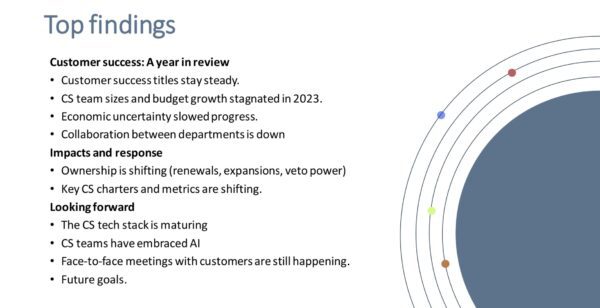The landscape of customer success has been evolving rapidly. So much so that we seem to be releasing new content on customer success just about every week.
Today we’re focusing on actionable insights you can use to drive down churn with customer success in today’s new era of SaaS efficiency. You Mon Tsang, CEO and co-founder of ChurnZero, Colleen O’Sullivan, VP of Integrated Customer Experience at Hubspot, and Jason Lemkin, SaaStr founder and CEO, give their take on where the customer success industry is headed and shares data from the Customer Success Leadership Study done by ChurnZero at the close of 2023.
This is the fourth annual Customer Success Leadership Study brought together by ChurnZero, ESG, SaaStr, and Hubspot. The report provides a definitive overview of the customer success landscape and features insight from more than 1,200 CS leaders worldwide — making it the largest study in the industry for customer success.
We’ll dive into the most interesting learnings and tactical takeaways together today including:
- How the economy has impacted customer success teams’ operations, measurements, and goals
- What CS budgets and departments look like today
- How AI will play a role in the customer success tech stack
Customer Success Should Be a Single-Digit Hire
You Mon Tsang, CEO and co-founder of ChurnZero says a tweet Jason made ten years ago is still relevant today, and it’s that customer success should be a single-digit hire. Meaning, it has to be one of the first ten people who join your company.
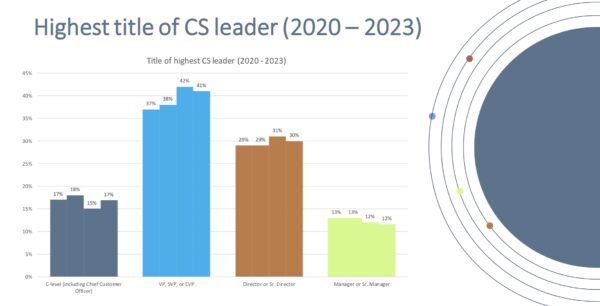
Looking at the data above, there’s a clear lack of change in the titles of CS leaders over the last few years, but it doesn’t mean customer success isn’t growing in importance. Now, more than ever, businesses are looking into their install base and figuring out how to protect their customers and do the right thing for them. While it feels like there are more CCOs than ever before, the data doesn’t reflect that, even in 2023. The Head of CS has become an amorphous reporting structure in SaaS at many scaleups and startups because no one wants to own customer success.
Who Owns Customer Success
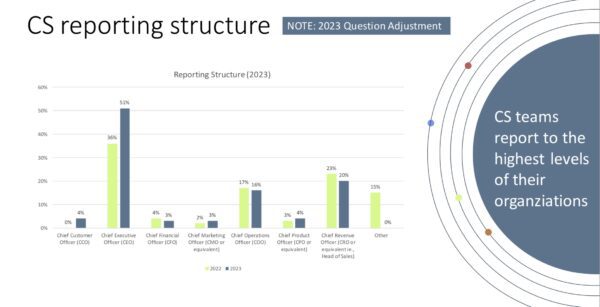
No one really wants to own customer success. The CEO doesn’t mind owning it in the beginning because all founders are passionate about their customers.
“We want to be profoundly involved in customer success,” Jason adds, “But do we wanna own it? Do we own the metrics and the people? No. I think the good news is that there are plenty of VP titles out there, but I don’t think we’ve solved this issue of who to customer success report to. And when I talk with CEOs and Founders, I answer that CS has to report to you. And maybe that’s good for customer success professionals because it gives them a seat at the table, but it’s not necessarily for the right reason. I still think it’s tough, but it’s not clear exactly who owns what.”
But in the end, no one wants to own customer success because it’s hard to articulate the value that the team is bringing. And during a growth phase, we become overwhelmingly growth-oriented to a fault. We all become new customer-oriented, so we say we’re focused on the existing base, but once the sales team becomes 30-40% of headcount, it tends to dominate every conversation. “What’s the next deal? What’s in the pipeline?”
There’s not a lot of oxygen left for maintaining customers. Any organization with triple-digit NRR needs to spend all its oxygen on making customers happy. But that’s not the way B2B businesses work. Founders have to fight this and force an unnatural way of working because, as humans, our energy doesn’t reflect our revenue structure. We don’t put the amount of energy into customer success that recurring revenue deserves in SaaS.
Are Customer Success Teams Growing or Shrinking
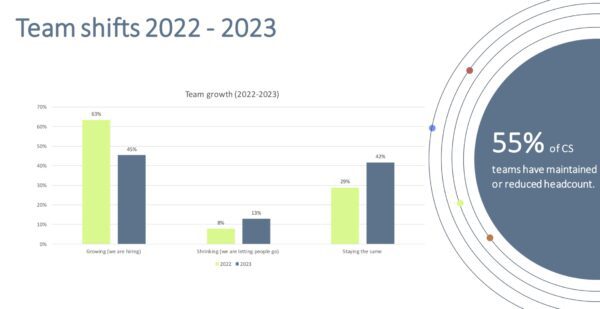
At the close of 2023, we asked the question of whether teams were growing or shrinking. You can see that the dark blue was 2023 and almost half of the CS teams were growing 45%. 42% stayed the same, and only 13% were letting people go, which was surprising with all the talks of SaaS layoffs.
If you look at the data, layoffs seem like a big deal. Without trivializing layoffs, a lot of startups and unicorns were overfunded, and layoffs mainly were small at public companies. All public companies did hiring freezes last year, which is a hidden layoff. And as much press as layoffs get, they aren’t as dramatic an impact overall as freezes and getting to efficiency are.
Hubspot also had a hiring freeze, but they were thinking about how to hire internally. They had to make tough choices about what teams they were investing in and dig into the existing employee base to see where there was an opportunity to shift direction.
Budgets Are Stagnating
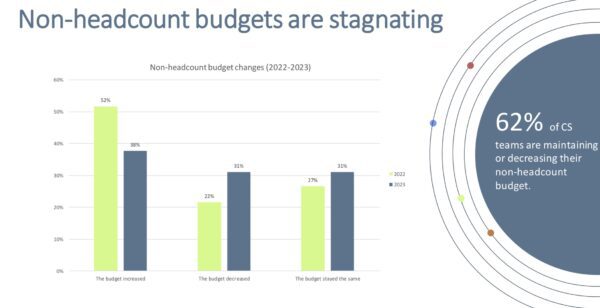
There are two areas that are “easy” where broad leadership can hold the line easily rather than increase expenditure.
- Long-term marketing spend
- Holding customer success spend flat
The study found that 62% of CS teams are maintaining or decreasing their non-headcount budget. A lot of companies’ marketing spending over the last 18 months pivoted to this quarter. There was this mentality of “What can I do for marketing spend?” Not for the brand or awareness, but right now.
There was plenty of budget for this quarter, but none for next year. This is still reverberating in marketing. Others want to hold CS spending flat. With Hubspot, people will renew because they have the highest NRR for SMBs. It’s not that you don’t want to spend, but maybe you can skip on 2024 marketing budget for customer success.
One thing that has positively changed for customer success, especially for the SMB-focused, is far larger onboarding teams. This is great news because onboarding is one of the best ways to bring down churn for SMBs. If someone never starts or uses the product, they’ll churn. It’s the critical piece for customer retention.
Team Size Compared to Benchmarks
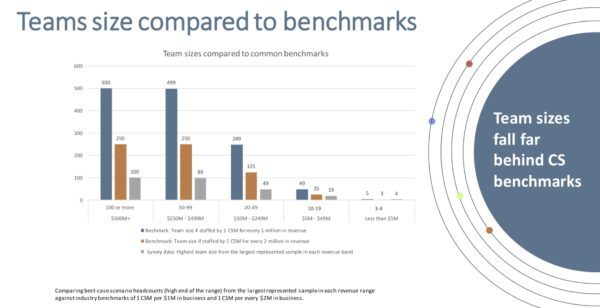
If your CSM owns a million-dollar book of business or if you’re a $500M business, you should have 500 CSMs. If they own a $2M book of business, they should have 250. But the biggest teams we saw were only 100 or 99 in this category. Jason says he wants the bars on the left to be true, but if you think about the fact that all CS expenses have to fit in 5% of your revenue, it has to be the one on the right.
Where you invest your humans and how they touch customers is what every CS team is thinking about. What is the value and impact you’re having with those interactions? Everyone is trying to figure out how to provide a great customer experience while also not being able to offer white glove service to everyone. And that’s where AI comes in.
If You Haven’t Embraced AI, You’re Falling Behind
Organizations are being asked to become more efficient and to do that, they’re looking to AI. For example, an SMB that barely logs into a computer should be able to onboard without the need for a human.
At Hubspot, they’ve found great AI use cases within CS and can replace human intervention with AI by understanding the customer’s journey. 43% of CS teams have adopted AI, which means that 57% have not. It feels hard to avoid AI now, and teams at Hubspot are hyper-focused on it because it’s how they will continue to scale.
“We are hyper-focused on this,” Colleen O’Sullivan, VP of Integrated Customer Experience at Hubspot explained. “Not just focused, but hyper-focused. This is it. This is how our teams will grow full-scale. Being able to give them the tools that provide them the right insight on their customers, the right, drivers for, how they manage their time efficiently and effectively understanding opportunities within their install base. It’s all this. And if we don’t get this right we will fail our customers. So this is absolutely critical for us as part of a massive focus area for CS.”
AI can change the game in two ways:
- Customer-focused experiences
- Automation
You want automation that makes the customer happy, and you want AI to support CS teams and other functions within an organization so they can be more effective at their jobs. If you can automate away 40% or more interactions and make them positive, it’s a game changer.
AI also helps drive the right behaviors by serving up the right information to a CS person so they don’t have to think about it. Plus, things like call summarization, content creation, and actions to take based on internal data are all helpful. AI has the power to analyze data from multiple sources and turn it into actionable insights in a way that humans can’t or at least can’t do easily.
Who Owns the Renewal Process?
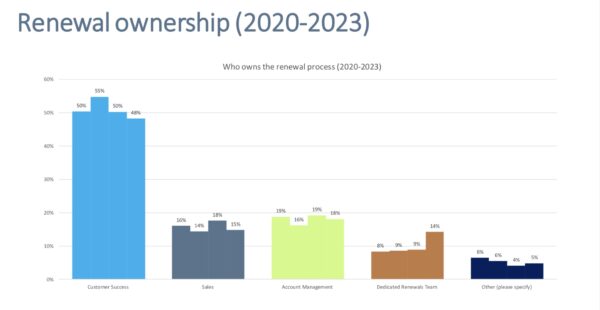
This has changed over the last four years. Surprisingly, CS has gone down, and there’s a rise in dedicated renewals teams. At Hubspot, there is a contract management team under the umbrella of customer success that owns some of the renewals process, and they’re measured on customer dollar retention. It’s a close partnership. They tap back into sales for upsells and cross-sells.
“This is telling and helpful to see,” Jason shares, “But tt’s also a bad sign.” Teams tasked with nothing but getting the most revenue out of customers aren’t going to be focused on customer happiness. Many times, these teams report to revenue when they’re under stress, which can cause negative customer experiences as well. In a downturn, people are looking for dollars, so it’s important to incentivize the right behaviors.
But how do you determine what a healthy and happy customer is?
There were some data points in the study around engagement being a big metric for CSM, but that might not be right. You need the right engagement. Hubspot looks at usage to ensure customers are using the tools in a way that helps them achieve their goals.
The Main Focus for CS Teams This Year
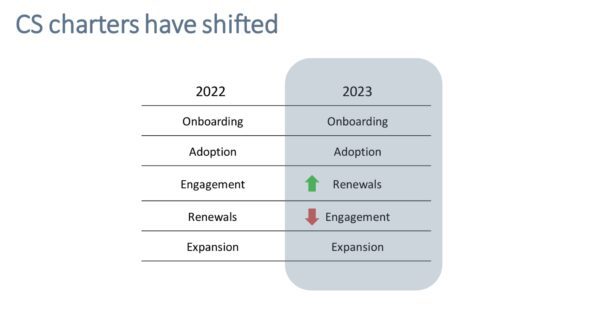
The main focus this year is onboarding, then adoption. Renewals have taken priority over engagement compared to 2022, and then expansion follows.
In the early days, we thought NRR was the right metric for growing CS teams, even though it’s lagging. It summarizes everything. Usually, you can’t have high NRR with angry customers. So, having variable comp tied to NRR goals made sense and still does with healthy scaling organizations.
But if there’s stress, usage and other metrics are better, like GRR. In tougher times, you want to take pressure off expansion at the bottom, and CS needs to be an ally of the customer. You can hide sins in NRR, but you can’t in GRR.
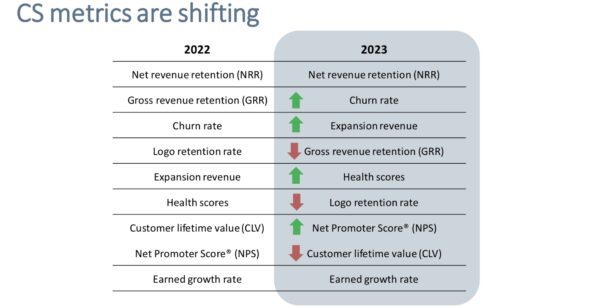
If their only task is growing logo retention, they will do everything possible to make the customer happy. Happy customers are the key to everything in SaaS.
Key Takeaways
